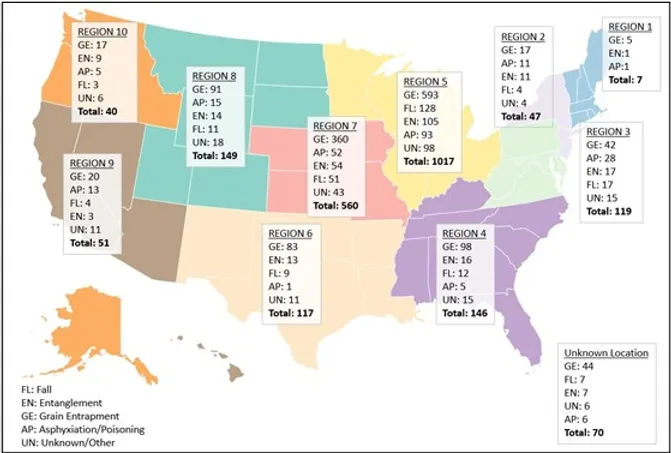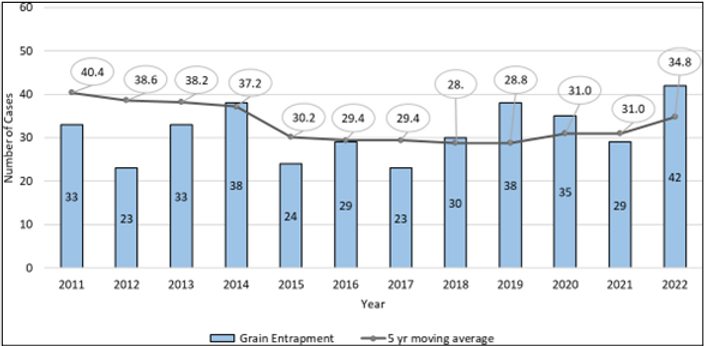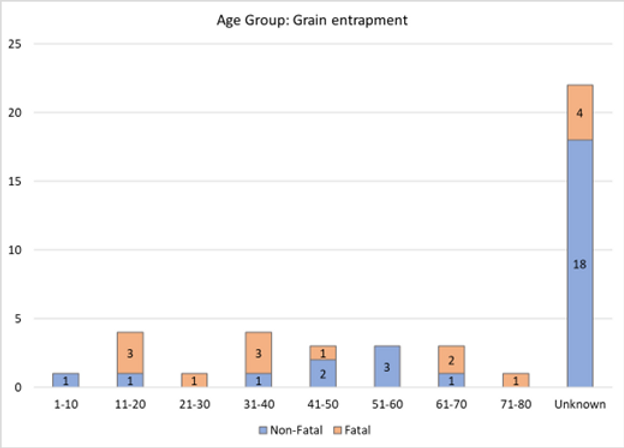2022 AG-RELATED CONFINED SPACE INCIDENTS
The following information is part of a report released by Purdue University’s Agricultural Safety and Health Program. This report is on reported agricultural confined space incident related injury and fatality cases documented during 2022. The program has documented and, entered into Purdue’s Agricultural Confined Space Incident Database, more than 2,460 fatal and non-fatal agricultural confined space cases since 1977.
Historical Statistics by OSHA Region
Agricultural confined space-related cases have occurred in every OSHA region but tend to be concentrated in regions 5 and 7.
- Region 5 has accounted for 43.8% of all agricultural confined space cases (1,017), with 58.3% of those cases being grain entrapments, and 12.6% being falls.
- Region 7 accounted for 560 cases (24.1% of the U.S. total) with grain entrapments, asphyxiation, and entanglements representing 83.2% of those cases.
- Region 1 represented the region with the smallest number of grain entrapments while Region 6, interestingly, represented the region with the highest percentage of total documented cases being grain entrapment cases (71%).

Agricultural confined case distribution by OSHA region from 1962-2022.
Grain Entrapments
There were 42 fatal and non-fatal grain entrapment cases documented in 2022. This represented a 44.8% increase from the 29 recorded in 2021 and substantially higher than the 5-year average (34.8 cases/year). The total of combined fatal and non-fatal grain entrapment cases was the highest annual frequency over the past decade. Nevertheless, the 5-year running average continues to be below its peak of 40.4 in 2011. Of the reported entrapment cases in 2022, 35.7% resulted in a fatality, lower than the five-year average. In 2022, the state with the most documented grain entrapments (fatal and non-fatal), was Iowa with nine. Minnesota followed with five, and both Indiana and Missouri had four cases each. Overall, grain entrapments were documented in 16 states in 2022. The majority of grain entrapment cases occurred in the Midwest, or Corn Belt states (64.3%).

Gender and Age
All documented grain entrapment cases in 2022 involved males. Five (12%) involved youth under the age of 21, a demographic that has represented up to 20% of cases in the past. The oldest victim of grain entrapment was 75. The average age was 41.3 years old, and the median age was 42. In over 52.4% of the cases, the specific age could not be documented. However, a review of the reports strongly indicates that nearly all were adults.

With over two-thirds of U.S. grain storage capacity being on farms that are exempt from OSHA injury reporting requirements, it is highly likely that this summary does not encompass all grain-related entrapments, whether resulting in death or not.
Contributing Factors
As found by Kingman nearly 20 years ago, there is a direct relationship between the probability of an entrapment in grain and the presence of out-of-condition, or spoiled grain. For many years, the term “flowing grain” was used to identify the entrapment hazards associated with grain storage and handling, when in fact it is non-flowing grain that poses the greatest risk. Nearly all cases examined in 2022, in which adequate details were available, involved grain that was non-flowing due to spoilage.
Contributing factors included attempting to store grain at moisture content levels above 14%, improper in-bin drying practices such as rewetting grain using moist outside air, and leaks in the structure that allowed moisture to have access to dry grain. In other words, far more grain-related entrapments could have been prevented (and lives saved) by promoting proper storage techniques than could be achieved with providing training on emergency grain rescue strategies.
Non-Grain Bin Related Incidents
Injuries and fatalities involving agricultural waste storage and handling facilities, transport equipment, and other livestock waste-related operations have been monitored as part of Purdue’s Agricultural Confined Spaces-related Incident Database (PACSID). These operations include aerobic digesters, bio-gas generators, and other confined spaces used to store and process waste. Approximately 505 related fatalities or serious injuries have been documented in the PACSID.
Findings
Findings gathered between 1975 and 2021 were summarized by Nour, et al. (2021). This summary analyzed a total of 409 incidents involving 486 individuals, out of which 288 (59%) were fatal. Of the total, 85% of these victims were male. Their average age was 37, remarkably younger than the average age of U.S. farmers. This indicates that youth and less experienced farmers were more prone to agricultural waste-related incidents.
The most frequently identified incidents involved underground and underfloor manure storage facilities, above-ground manure storage tanks, sump pits, ponds, lagoons, manure digesters, and manure transport vehicles such as portable tankers, applicators, and spreaders. Fifty-three of the incidents, or approximately 11% of all cases documented, involved multiple victims.
Breakdown
Historically, there were 11 injuries and fatalities documented in 2020 related to livestock waste, out of which 5 (45%) were reported as fatal. The number of cases documented in 2021 jumped to 13 incidents involving 16 individuals (cases). Of these cases, 12 were fatal (75%). This doubled the number of fatalities documented in 2020.
In 2022, 11 incidents involving 11 individuals were documented. Out of the 11, 8 cases were fatal (73%). All the victims were male, including a 16-year-old youth. The ages of four of the victims were undetermined. The oldest victim was age 74. Three of these incidents occurred in Wisconsin, and two in California. Ohio, New York, Minnesota, Indiana, Maryland, and Pennsylvania each reported one case in 2022. In addition, there were 8 non-fatal roadway collision incidents involving livestock waste transport vehicles.
The most frequently identified activity causing confined space incidents injuries or fatalities in 2022 was performing maintenance tasks in or around manure storage structures, such as pump repairs or service. This has been the most frequent activity identified in all cases documented since 1975.
We would like to thank Dr. Bill Field, Professor at Purdue’s Agricultural and Biological Engineering Department, and his staff for the information provided and their continued efforts to prevent injuries and fatalities in agricultural confined spaces.
Related Links:
- Confined Space Entry Training
- Oxygen Deficiency in Confined Spaces
- Full Course Catalog – Safety Made Simple
Joe Mlynek is a partner and subject matter expert at Safety Made Simple, LLC. He has over 25 years of experience in safety at the corporate level and as a consultant. He is a Certified Safety Professional (CSP) and Occupational Safety and Health Technician (OHST). Joe can be reached at joe.mlynek@safetymadesimple.com
